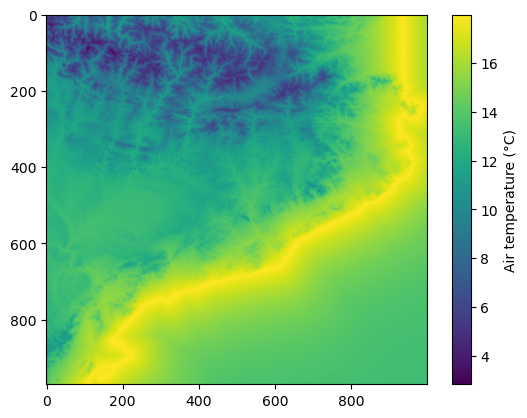05. Interpolation - Multiple Linear Regression#
In this tutorial, we’ll cover the interpolation of point data using the
Multiple Linear Regression (MLR) methodology, available in PyMica as
mlr. This methodology requires location (lon and lat),
predictor variables such as altitude (altitude) or distance to coast
line (among others), and value to interpolate.
We’ll use Meteorological Service of Catalonia sample data to demonstrate how to apply this interpolation technique. Therefore, we need to import the required modules. First, we need to load observation data and also the PyMica class.
import json
from pymica.pymica import PyMica
Let’s call the PyMica class with the appropriate parameters, setting the
methodology to mlr and the configuration dictionary as follows:
config_file = 'sample-data/configuration_sample.json'
with open('sample-data/configuration_sample.json', 'r') as f_p:
config = json.load(f_p)
config['mlr']
{'clusters': 'None',
'variables_files': {'altitude': 'sample-data/explanatory/cat_dem_25831.tif',
'dist': 'sample-data/explanatory/cat_distance_coast.tif'},
'interpolation_bounds': [260000, 4488100, 530000, 4750000],
'resolution': 270,
'EPSG': 25831}
where:
clusters: set to None as no clusters will be used.variables_files: dictionary with predictor variables as keys and their corresponding GeoTIFF path as values. Here, altitude asaltitudeand distance to coast line asdist.interpolation_bounds: [minimum_x_coordinate, minimum_y_coordinate, maximum_x_coordinate, maximum_y_coordinate], it must be the same as the variable files.resolution: spatial resolution.EPSG: EPSG projection code.
With all these parameters and configurations set, let’s initialize the
PyMica class with the methodology set to ‘mlr’.
mlr_method = PyMica(methodology='mlr', config=config_file)
Now that we have the interpolator set, we can input some data for interpolation. We will use data from the Meteorological Service of Catalonia AWS network.
with open('sample-data/data/smc_data.json', 'r') as f_p:
data = json.load(f_p)
data[0]
{'id': 'C6',
'value': 8.8,
'lon': 0.9517200000000001,
'lat': 41.6566,
'altitude': 264.0,
'dist': 0.8587308027349195}
As we can see, the first element of the data meets the requirements of
PyMica input data and has the same predictor variables as the ones
provided in the configuration dictionary. Therefore, we only need to
call the interpolate method from the mlr_method interpolator
class.
data_field = mlr_method.interpolate(data)
Now, we can get a quick look of the data_field array using
matplotlib.
import matplotlib.pyplot as plt
plt.imshow(data_field)
plt.colorbar(label='Air temperature (\u00b0C)')

Finally, we can save the result into a GeoTIFF file using
pymica.pymica.PyMica.save_file() from PyMica class.
mlr_method.save_file("sample-data/results/mlr.tif")
We have now completed this tutorial on how to interpolate station data
using the mlr methodology. You can experiment with changing the
variables_files in the configuration dictionary to observe how the
behavior of each variable affects the interpolation result.
